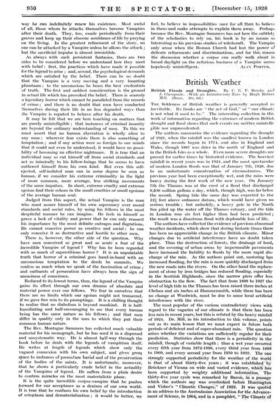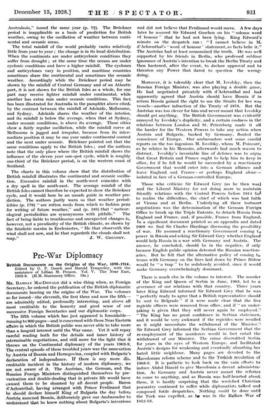British Weather
BritiSh - Floods' and Droughts. By C. E. - Brooks and J. Orlasspoole. .With. an Introductory-Note bk Hugh RObert -Tux 'fickleness- of :British 'weather: is: gerierally -accepted as inevitable. Its- freaks are the act of God'? or " our climate is not what it used -to The -interesting colleetion -in this Work'of informatkin i•egaiding the extreines of inodern-Britisli droiight and flood silo-WS-that such events-are neither unintelli
gible nor -unprecedented. - - - • _ .
• The :authors summarize the evidence regarding -the drought of 1921, when the rainfall was :the SMalleSt=kriwn -in London since' t 'fie records began in -17/74,:- and • 'also in England- and Wales, though 1887 was drier in the north of England and in the British Isles as a whole. Even more severe droughts are proved for earlier times by historical evidence. The heaviest rainfall in recent years was in 1924, and the most spectacular of modern London floods was that of January 7th, 1928, due to an unfortunate concatenation of circumstances. The previous year had been exceptionally wet, and the rains were heavy during the first week of the new year. On January 7th the Thames was at the crest of a flood that diScharged 9,590 million gallons a day, which, though high, was far below the record. Spring tide the same day was expected to rise 12i feet above ordnance datum, which would have given no serious trouble ; but unluckily, a heaVy gale in the -North Sea piled up the water off the Thames estuary, and the tide in London rose six feet higher than had been predicted ; the result was a disastrous flood with deplorable loss of life,
The authors have collected the evidence of previous abnormal weather incidents, which show that during historic times there has been no appreciable change in the British climate. Minor changes due to artificial 'interference have no dOubt taken place. Thus the destruction of forests, the drainage of land, and the covering of urban areas by impermeable pavements have increased the liability to floods by 'the more 'rapid dis- charge of the rain. As the authors point out, motoring has increased flooding, for the rain is More quickly discharged froM the new roads into the rivers. On the other hand the replace- ment of stone by iron bridges has reduced flooding, especially in the Scottish Highlands, since the narrow piers offer less obstruction to the flow. The fact that from 1898 to 1927 the level of high tide in the Thames has been raised three inches at Chelsea and six inches at Hammersmith, while, there has been no change at Woolwich, must be due to some local artificial interference with the river.
The most popular of the various contradictory views with regard to the vagaries of our climate is that there has been
less rain in recent years, but this is refuted by the heavy rainfall
of 1924. Dr. Mill, in his introduction to this volume,' points out as its main lesson that we must expect in future both
periods of deficient and of super-abundant rain. The question arises whether the variations are sufficiently regular for their prediction. Statistics show that there is a periodicity in the
rainfall, though of variable length ; thuS a wet year occurred every fifth year from 107271836, every third year from 1888 to 1909, and every second year from 1910 to 1922. The one
strongly supported periodicity for the weather of the : , •
is that of about thirty-five years ; it was established by BrUckner of Vienna on wide and varied, evidence, which hag been supported by weighty additional information The thirty-five year cycle was_ remarked by Bacon, in a passage which the authors say was overlooked before Auntington and Viaher's "Climatic. Changes," of 1922. It was quOted in an address to the Australasian Association for the Advance- ment of. Science, in 1,904,: and in a pamphlet, !`The 'Climate of
Australasia," issued the same year (p. 72). The BrUckner period is inapplicable as a basis of prediction for British weather, owing to the oscillation of weather between conti- nental and oceanic areas.
The total rainfall of the world probably varies relatively little from year to year ; the change is in its local distribution.
When the continents are under anticyclonic conditions they suffer from drought ; at the same time the oceans are under cyclonic conditions and have a higher rainfall. The cyclones and anticyclones vary in position, and maritime countries sometimes share the continental and sometimes the oceanic weather. Accordingly while the Bruckner period may be shown by the rainfall of Central Germany and of an Atlantic port, it is not shown for the British Isles as a whole, for one part may receive lighter rainfall under continental, while another has extra rain under oceanic conditions. This fact has been illustrated for Australia in the pamphlet above cited, by the contrast between the rainfall of Adelaide, Melbourne, and Sydney. Adelaide shares the weather of the interior, and its rainfall is below the average, when that at Sydney, under oceanic conditions, is above its average. Those cities show a fairly regular oscillation, while the rainfall curve at Melbourne is jagged and irregular, because from its inter- mediate position it may be one year under continental control and the next under oceanic. Bruckner pointed out that the same conditions apply to the British Isles ; and the authors note that the only place where the British rainfall shows the influence of the eleven year sun-spot cycle, which is roughly one-third of the Bruckner period, is on the western coast of Scotland.
The charts in this volume show that the distribution of British rainfall illustrates the continental and oceanic oscilla- tion. Excessive rainfall in the north-west coincides with a dry spell in the south-east. The average rainfall of the British Isles cannot therefore be expected to show the Bruckner cycle, and it would here be an unsafe guide in weather pre- diction. The authors justly warn us that weather period- ieities (p. 179) " are rotten reeds from which to fashion pens for writing of future weather," and (p. 189) that ‘' meteor- ological periodicities are synonymous with pitfalls." The fact of being liable to troublesome and unexpected changes is, however, not a peculiarity of the British climate, as shown by the fatalistic maxim in Ecclesiastes, He that observeth the wind shall not sow, and he that regardeth the clouds shall not









































 Previous page
Previous page